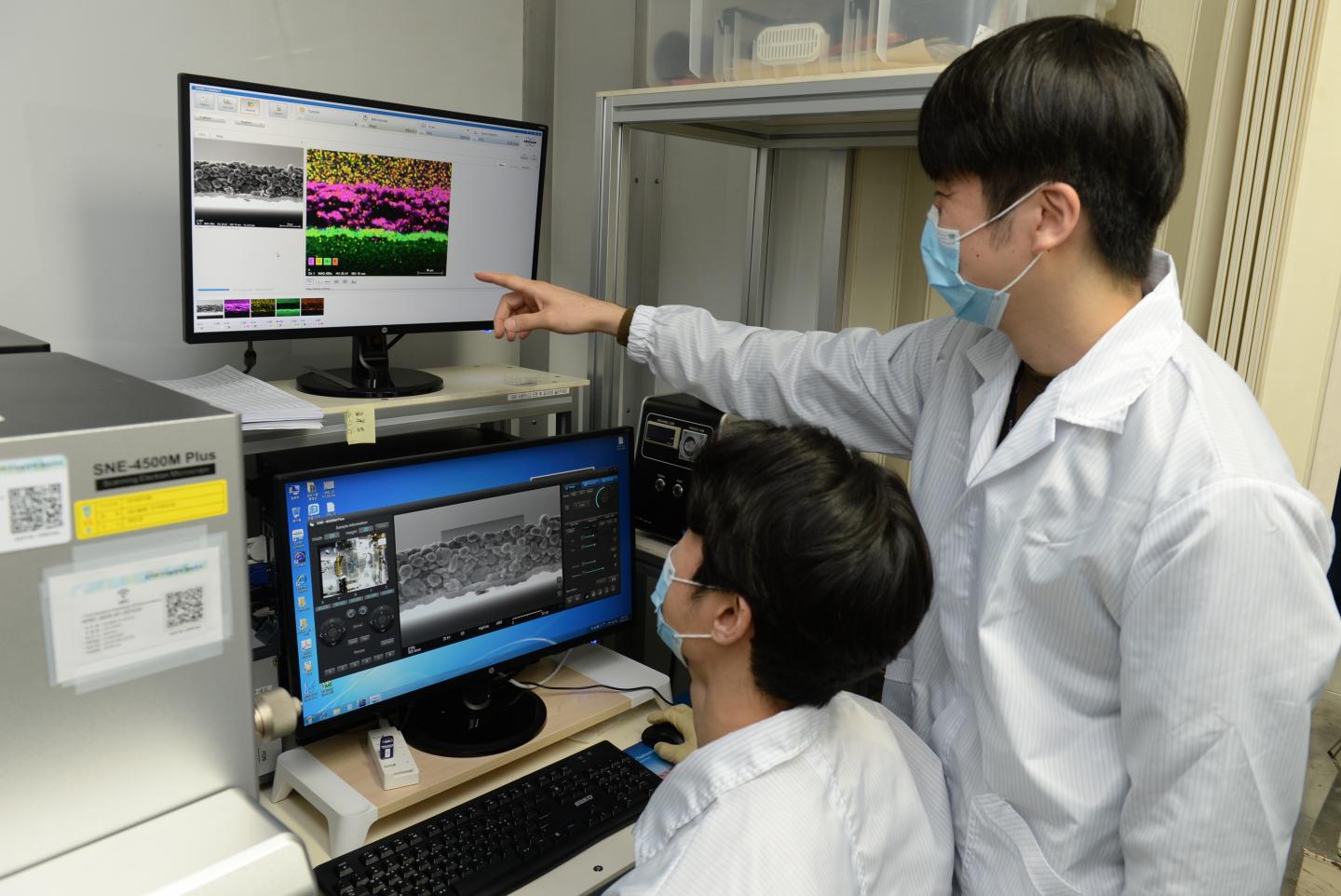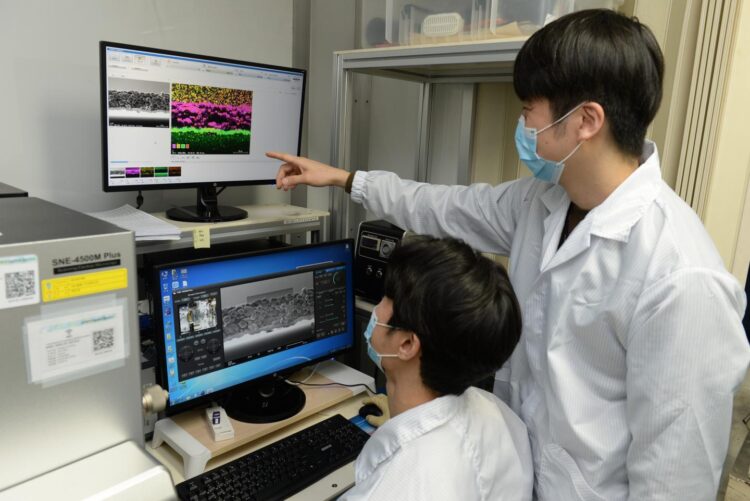All-solid-state electrodes composed of graphite active material and no solid electrolyte. Energy density was improved by 150% through research on the particle diffusion process.

Credit: Electronics and Telecommunications Research Institute(ETRI)
South Korean researchers have developed a new type of electrode structure for all-solid-state secondary batteries. If this technology is adopted, the energy density of the batteries could increase significantly when compared to existing technologies, contributing tremendously to the development of high-performance secondary batteries.
A joint research team from Electronics and Telecommunications Research Institute (ETRI) and Daegu Gyeongbuk Institute of Science and Technology (DGIST) announced that it had designed a new electrode structure for all-solid-state secondary batteries after identifying the mechanism of facile lithium-ion diffusion between active materials. The achievement received international recognition when the results were published by the ACS Energy Letters, an international online academic journal specializing in the energy sector which is run by the American Chemical Society (ACS)*.
Unlike primary cells that can be only used once and never be able to be reused, secondary batteries can be recharged and used repeatedly. With the recent advances in electronic devices, the importance of secondary battery technology to robots, electric cars, energy storage systems (ESS), and drones is growing year by year.
All-solid-state secondary battery is a next-generation energy storage device that uses a solid electrolyte to transport ions within battery electrodes. Solid electrolytes are safer than liquid electrolytes which can cause a fire. Moreover, solid electrolytes can be implemented in a bipolar-type secondary cell* to increase energy density by a simple battery configuration.
The electrode structure of a conventional all-solid-state secondary cell consists of a solid electrolyte responsible for ionic conduction, a conductive additive that provides the means for electron conduction; active material responsible for storing energy; and a binder that holds these constituent parts physically and chemically.
ETRI researchers discovered through systematic experiments, however, that ions are transported even between graphite active material particles. And they proposed a new type of electrode structure for all-solid-state secondary cell consisting of only the active material and the binder. The researchers confirmed the possibility that even without a solid electrolyte additive within the electrodes, the performance of an all-solid-state secondary cell could be superior.
The theoretical feasibility of the novel structure proposed by ETRI was verified at DGIST through electrochemical testing (using a supercomputer) of a virtual model. ETRI researchers succeeded in demonstrating this structure in an actual experiment. ETRI named this technology ‘diffusion-dependent all-solid-state electrode’ and submitted a paper to an international journal.
If ETRI’s technology is adopted, solid conduction additive material will become unnecessary in the electrode; instead, the more active material can be squeezed into the same volume. In other words, the amount of active material in the electrode can increase by up to 98wt%* and as a result, the energy density* can be made 1.5 times greater than the conventional graphite composite electrode.
The technology offers advantages in manufacturing process aspects as well. Sulfide-type solid electrolytes*, which have high ion conductivity and moderate plasticity, are regarded as an excellent candidate for the fabrication of all-solid-state batteries. But due to its high chemical reactivity*, the sulfide-type solid electrolytes leave battery developers with very few options when it comes to solvents and binders. In contrast, with the new ETRI electrode, developers can freely select the type of solvent and binder to use in the battery because the electrode contains no solid electrolytes that are highly reactive. This also permits researchers to pursue new approaches for improving the performance of all-solid-state secondary cells.
Dr. Young-Gi Lee, who was involved in this research, said, “We have revealed for the first time that ions can be diffused just with active materials. We are no longer bound to the structure used in existing all-solid-state secondary cells. We plan to develop secondary cells with even high energy densities, using this technology. We will also secure our rights to the core technology and work on a version that could be commercialized.”
Although ETRI conducted its research using graphite cathode active material, it intends to continue its research based on the same concept, using various other electrode materials. It is also planning to enhance the technology in order to increase efficiency. This can be accomplished by eliminating the interfacial issues between electrodes and thinning the volume of electrodes.
###
Glossary description:
* ACS Energy Letters IF: 19.003, Electrochemistry JCR: 98.148
* a bipolar-type secondary cell: High energy density secondary cell containing several electrodes connected in series with a single rechargeable battery cell.
* Mass percentage: In chemistry, the mass percentage of a substance in a mixture is the ratio of the mass of the substance to the total mass of the mixture.
* ETRI’s electrode: >640 mAh/cm3, conventional graphite composite electrode: ~400 mAh/cm3.
* Compounds containing or binding to a sulfide ion (S²-) in the formula
* When sulfur (S) and moisture (H2O) meet, hydrogen sulfide, a toxic gas, is released.
About Electronics and Telecommunications Research Institute (ETRI):
ETRI is a non-profit government-funded research institute. Since its foundation in 1976, ETRI, a global ICT research institute, has been making its immense effort to provide Korea a remarkable growth in the field of ICT industry. ETRI delivers Korea as one of the top ICT nations in the World, by unceasingly developing world’s first and best technologies.
This research was carried jointly with Prof. Yong Min Lee and his team from DGIST under the auspices of ETRI. The first authors of the paper are Dr. Ju Young Kim of ETRI and Dr. Joonam Park of DGIST. The corresponding authors of the paper are Dr. Ju Young Kim of ETRI and Prof. Yong Min Lee of DGIST, and the research was funded by the Ministry of Science and ICT as part of the Climate Change Response Technology Development Project (National Research Foundation of Korea).
An article explaining the results of this research was published in the latest issue of ACS Energy Letters, a renowned international journal in the Energy field (IF:19.003).
Media Contact
Kil-ho Chong, Ph.D.
[email protected]
Related Journal Article
http://dx.





